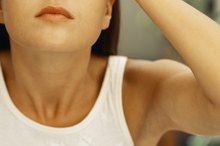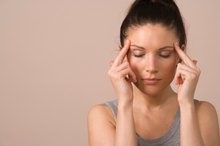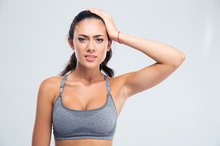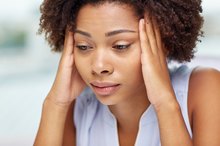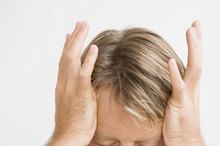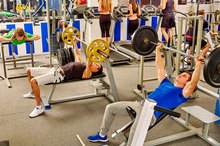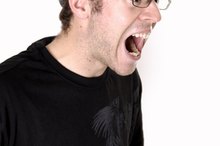A Sharp Pain in the Head When Exercising
Although many people find relief from chronic headaches by undertaking a healthy eating and exercise schedule, an unlucky few find that working out causes sharp head pain. Rather than ignoring this symptom and powering through the pain, consult your doctor to rule out serious causes. If possible, keep a journal of your daily routine to determine whether there's any correlation between your lifestyle and your workout headaches, or if other symptoms may point to a diagnosis.
Types of Head Pain
If the pain lasts only a few seconds and is triggered by even slight movement, you may have trigeminal neuralgia, a kind of nerve damage. Other types of exercise headaches may last longer and may be accompanied by other symptoms. If the pain in you head goes on for several days or is accompanied by secondary symptoms such as vomiting, double vision, passing out or a stiff neck, seek immediate medical attention. Possible conditions range from sinus infection to bleeding in the brain and arterial blockage. Primary exercise headaches without additional symptoms don't have an underlying condition and may be related to factors that constrict blood vessels. Even if your workout headaches don't feature secondary, dramatic symptoms, it's always best to ask your doctor is you need a physical examination in order to clear you for continued exercise.
- If the pain lasts only a few seconds and is triggered by even slight movement, you may have trigeminal neuralgia, a kind of nerve damage.
Improper Nutrition and Hydration
Pain in the Base of the Head During Exercise
Learn More
Brown University’s Health Education program says that some people throw themselves into a weight-loss program by skipping meals and exercising vigorously. One of the dangers is an increased incidence of headaches during workouts. Poor eating habits may lead to hunger headaches; the related dehydration also may contribute to the pain in your head. To avoid these side effects, think like a seasoned athlete when you craft your workout plan. Get the nutrients and fluids you need to fuel your body through a workout, especially on hot and humid days.
- Brown University’s Health Education program says that some people throw themselves into a weight-loss program by skipping meals and exercising vigorously.
Caffeine Withdrawal
Some head pains during physical exertion may stem from caffeine withdrawal, according to Rice University. If you normally drink coffee, tea, soda or other caffeinated beverages, your blood pressure is increased slightly. This increase is not necessarily a threat to your health, but if you suddenly go without caffeine for about 18 hours, the change in blood pressure can cause blood vessel constriction and related pain. Headaches as a result of caffeine withdrawal are common and seem to be worsened by exercise, the university says. If you suspect that caffeine and its effects may be causing the sharp pain in your head during workouts, either slowly cut back on caffeinated beverages or have a cup of coffee or tea a few hours before exercising to avoid withdrawal headaches.
- Some head pains during physical exertion may stem from caffeine withdrawal, according to Rice University.
- If you suspect that caffeine and its effects may be causing the sharp pain in your head during workouts, either slowly cut back on caffeinated beverages or have a cup of coffee or tea a few hours before exercising to avoid withdrawal headaches.
Unexplained Head Pain
Left-Sided Headache After Workouts
Learn More
Sometimes no secondary condition exists to explain sharp head pain during workouts, nor are lifestyle choices to blame. In these cases, some people may simply have systems that respond to physical exertion by constricting the blood vessels, according to Mayo Clinic. This constriction leads to sharp or throbbing head pain.
Treatment and Prevention
If a secondary condition causes head pain during workouts, treatment varies depending on the root cause. Nerve-related conditions such as Trigeminal Neuralgia, for example, may respond to anti-convulsing medication. Tumors or brain bleeding may require surgery or other aggressive therapy. For unexplained sharp pains that seem to be unrelated to caffeine, dehydration or poor nutrition, your doctor may prescribe blood pressure medication to ease constriction of blood vessels during workouts. You may also find relief by switching to another kind of exercise, or by working out during the coolest times of the day or in an air-conditioned gym. Monitor your caffeine intake and stay hydrated and well nourished before exercising.
- If a secondary condition causes head pain during workouts, treatment varies depending on the root cause.
- You may also find relief by switching to another kind of exercise, or by working out during the coolest times of the day or in an air-conditioned gym.
Related Articles
References
- Mayo Clinic: Exercise Headaches
- Brown University Health Education: Headaches
- National Pain Foundation: Neuropathic Pain in Head and Neck
- Sajadi-Ernazarova KR, Hamilton RJ. Caffeine, Withdrawal. Treasure Island, FL: StatPearls Publishing. Updated July 30, 2019.
- Juliano LM, Huntley ED, Harrell PT, Westerman AT. Development of the Caffeine Withdrawal Symptom Questionnaire: Caffeine withdrawal symptoms cluster into 7 factors. Drug Alcohol Depend. 2012;124(3):229-234. doi:10.1016/j.drugalcdep.2012.01.009
- Juliano LM, Griffiths RR. A critical review of caffeine withdrawal: empirical validation of symptoms and signs, incidence, severity, and associated features. Psychopharmacology. 2004;176(1):1-29. doi:10.1007/s00213-004-2000-x
- Meredith SE, Juliano LM, Hughes JR, Griffiths RR. Caffeine Use Disorder: A Comprehensive Review and Research Agenda. J Caffeine Res. 2013;3(3):114-130. doi:10.1089/jcr.2013.0016
- Satel S. Is caffeine addictive?--a review of the literature. Am J Drug Alcohol Abuse. 2006;32(4):493-502. doi:10.1080/00952990600918965
- Addicott MA. Caffeine Use Disorder: A Review of the Evidence and Future Implications. Curr Addict Rep. 2014;1(3):186-192. doi:10.1007/s40429-014-0024-9
- Diamond S, Franklin MA. The Fasting Headache. National Headache Foundation. 2018.
- Da Silva AN, Lake AE. Clinical Aspects of Medication Overuse Headaches. Headachexx. 2014;54(1):211-217. doi:10.1111/head.12223
- World Health Organization. Atlas of Headache Disorders and Resources in the World 2011.
- Lipton RB, Diener HC, Robbins MS, Garas SY, Patel K. Caffeine in the management of patients with headache. J Headache Pain. 2017;18(1):107. doi:10.1186/s10194-017-0806-2
- American Migraine Foundation. Caffeine and Migraine. 2017.
- United States Department of Agriculture (USDA). Tea, hot, leaf, black. FoodData Central. 2019.
- Sweeney MM, Meredith SE, Juliano LM, Evatt DP, Griffiths RR. A randomized controlled trial of a manual-only treatment for reduction and cessation of problematic caffeine use. Drug Alcohol Depend. 2019;195:45-51. doi:10.1016/j.drugalcdep.2018.10.034
- American Migraine Foundation. Understanding Caffeine Headaches. 2017.
- Lee MJ, Choi HA, Choi H, et al. Caffeine discontinuation improves acute migraine treatment: a prospective clinic-based study. J Headache Pain. 2016;17:71. doi:10.1186/s10194-016-0662-5
- Bigal ME, Sheftell FD, Rapoport AM, et al. Chronic daily headache: identification of factors associated with induction and transformation. Headache. 2002;42(7):575-81.
- Headache Classification Committee of the International Headache Society (IHS). The International Classification of Headache Disorders, 3rd edition (beta version). Cephalalgia. 2013 Jul;33(9):629-808. doi: 10.1177/0333102413485658.
- Sigmon SC, Herning RI, Better W, et al. Caffeine withdrawal, acute effects, tolerance, and absence of net beneficial effects of chronic administration: cerebral blood flow velocity, quantitative EEG, and subjective effects. Psychopharmacology (Berl). 2009;204(4):573-85. doi: 10.1007/s00213-009-1489-4.
Resources
Writer Bio
Ellen Douglas has written on food, gardening, education and the arts since 1992. Douglas has worked as a staff reporter for the Lakeville Journal newspaper group. Previously, she served as a communication specialist in the nonprofit field. She received her Bachelor of Arts from the University of Connecticut.
